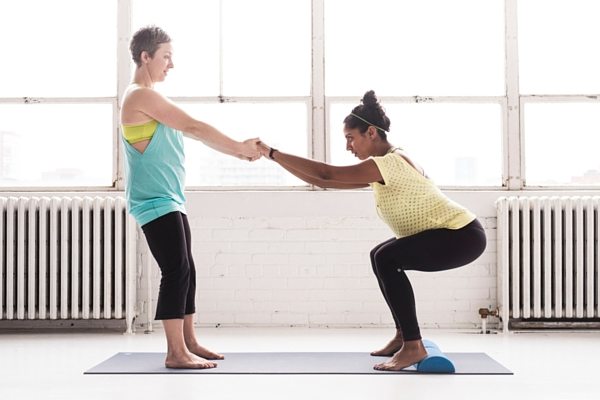UPDATED: April 30, 2025
My pelvic floor health was not something I actually set out to fix.
When I used to run and get shin splints, my main treatment goal was fixing my shins. I didn’t really think at all about the little bit I might have peed while I was belting out my 10 ks. It didn’t hurt, and so it was totally under my radar. In fact, it wasn’t until I started my movement certification that I clued in. Peeing when I ran was actually a serious warning sign about my pelvic floor health.
The good news, for me, is that my movement practice has entirely fixed my pelvic issues. They just happened less and less over time. Now, each time I sneeze I get a little glow of happiness that everything down there works, all by itself, perfectly. I’ll never be certain exactly what fixed me, but here are three things that you can do right away to help nourish the health of your pelvic floor. Actually four things. I couldn’t resist.
Fix #1 Quit Your Spinning Class And Get Off The Treadmill And Elliptical Machines.
When you spin, run on a treadmill, or climb an elliptical, you’re spending a LOT of time flexing your hips. This tends to shorten and tighten the muscles at the front of your hips (aka the hip flexors).
In short, tight hip flexors make it almost impossible for you to get your leg behind your pelvis (a motion called hip extension). Which is a problem, because hip extension during walking is a KEY part of strengthening your pelvic floor muscles.
The solution? Stop biking and running on machines. Go for lots of walks instead. Ideally, walk on hilly terrain and natural surfaces, while wearing minimal shoes. Also, do some psoas releases, they will help your body regain its ability to extend at the hips.
Want to learn more about walking technique? Try this blog post.
Fix #2 Shift Your Weight Back Towards Your Heels When You Stand.
99% of the people I see around me stand with their pelvis way out in front of their heels. Standing like this means shortening & tightening your pelvic floor muscles. And short, tight muscles are weak muscles.
Wanna see what I mean by shortening and tightening? Check out what happens to my butt as I move my pelvis forward….if you’re always standing with your pelvis way out in front, then your pelvic floor muscles are constantly going to be help in a short position as well.
Try this simple experiment:
Stand in bare feet and close your eyes.
Check in with your feet – where do you feel the weight of your body being held?
Can you sway your weight all the way forward? Feel how your weight transfers towards your toes and notice what happens to your gluteal region. It’s subtle but watch the wrinkles.
And then slowly sway back so that your weight moves to your heels and your toes lift up. Does it feel really unsteady? That’s pretty normal for anyone who’s used to standing forward. Go back and forth a couple of times and then finish up with your weight as far back as you can get it without you having to tense your quads or your back or anything else.
That can be your new standing position – and when it starts to feel more normal, you can work on getting even further back, until your hips are vertically aligned over your heels. (For more tips on finding hips over heels alignment, check out this video.)
Not coincidentally, you won’t be able to get into this hip over heel alignment correctly if you’re wearing shoes with a lift in the heels.
Fix #3 Stop Doing Kegels.
Really. I know you’re doing them for your pelvic health. But unless you’re working with a pelvic floor PT, you’re probably not helping the situation.
The thing is, most people do Kegels by squeezing their PF muscles. In other words, by consciously attempting to make your pelvic floor even SHORTER and even TIGHTER than it already is.
A short, tight muscle is a weak muscle. It can’t respond to loads (like 10 km runs) because it doesn’t have any ability to contract more than it’s already doing. Hello, sneeze pee.
So, if you’re practicing an exercise that shortens and tightens your PF muscles then you’re probably making the problem worse.
So stop, relax, and go for a walk.
Start healing your pelvic floor, building a functional core & caring for your spine (for free!)
Bonus Tip: Wear Shoes With Lower Heels.
A rise in the heel throws your entire body out of alignment. Heels force your pelvis forward as well as changing your gait patterns. So heels are a definite no!
But many of us have been wearing shoes with heels our entire lives.
Even the people who are out here reading this who only wear flats and who think I’m not talking to them. Sadly, most flats are not actually flat. So almost everyone needs to transition to a zero-drop shoe. Buuuuut, you might not want to do it all at once if you’ve been a heel-wearer for a long time.
Here’s a bunch of info about how to pick shoes that are better for your pelvic floor. And in the meantime, see if you can walk around the house barefoot.
Pelvic Floor Fixes
To recap – here are three four easy things you can start doing RIGHT NOW to help your pelvic floor:
1️⃣ Swap walking in real life for time on treadmills, spinning bikes and elliptical machines
2️⃣ Pay attention to how you’re standing & stand with hips over heels
3️⃣ STOP doing Kegels
4️⃣ Bonus tip – switch to minimal shoes & spend more time barefoot
Almost everyone will benefit from these three four simple pelvic floor fixes, and they don’t take any extra time, unless you count the time you spend shopping for new, better shoes! Win win!
I can never resist adding a bit more, so if you want one more major tip, sign up here for my Ribcage Magic giveaway. You’ll learn better ribcage alignment, which is a huge game changer for your core & pelvic floor – and the perfect complement to your new hips over heels standing!







